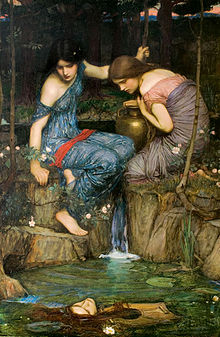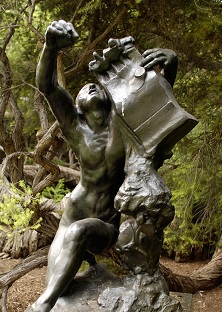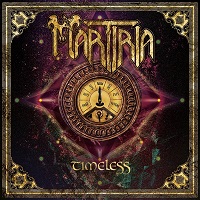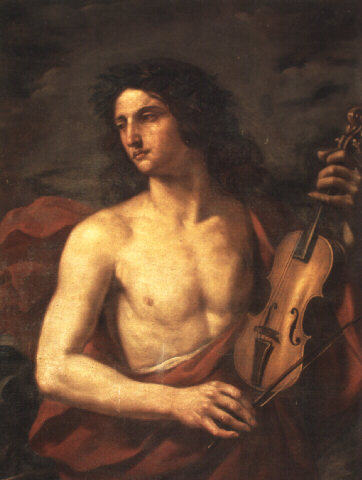|
|
|
|
Shortly about us
Martiria is an epic/doom metal
rock band formed back in the '80s and re-founded (after
a long pause) in 2002. Seven album published (last one R-Evolution, with ex Black Sabbath Vinny Appice - 2014).
The band was formed back in the '80s. At the beginning the
band was very much oriented towards Doom/Metal sounds such
as: early Candlemass and Black Sabbath. After releasing
just a few demos and featuring various musicians, in 1998
the members of the group decide to take a break for a while
in order to experience different projects. (continue) |
|
News and LIVE shows
Uh... it seems we have none planned right
now.
Why
don't you invite is in your local club?
mrc@martiria.com
(Booking info & more)
|

Info
& booking
info@martiria.com
|
King
of Shadows
(Menarini - Capelli)
from the album R-EVOLUTION
(2014)
|
Orpheus
was a legendary musician, poet, and prophet in ancient Greek
religion and myth. The major stories about him are centered
on his ability to charm all living things and even stones
with his music, his attempt to retrieve his wife, Eurydice,
from the underworld, and his death at the hands of those who
could not hear his divine music.(...) (source wikipedia)
Moreover, for the Greeks, Orpheus was the
founder and prophet of the "Orphic"
mysteries.
Orpheus, by Cesare
Gennari (1637-1688)
|
|
|
Every chord is a rolling thunder
meant to be heard from down under.
Every note is a promise of war
sent straight through the other shore!
She was young, she was mine,
made (of) honey’n’musk
She’s been taken by the dusk.
My guitar roars, my voice won’t quiver;
I’ll sing a song without shiver
That none on Earth would dare to play!
I cry, I die, I loose the way.
Her hair was long,
her touch light.
She doesn’t belong
To cold and night.
I’ll break the walls,
I’ll crush the doors!
Silence, through the caves,
flows across the waves.
Old and dark life tree,
give her back to me!
Or I’ll come till the halls of Hell
where (the) gray King of Shadows dwells.
(Menarini - Capelli 2014)
Orphée
aux enfers (Orpheus in the
Underworld) is an "operetta" by Jacques
Offenbach (1819-1880). The French text was written
by Ludovic Halévy. The most famous part of it is surely
the The "Infernal Galop" from Act II, also
known as Can-Can.
|

Nymphs Finding the Head of Orpheus
by Pre-Raphaelite
painter John
William Waterhouse (1849-1917)
The most famous story in which
Orpheus figures is that of his wife Eurydice.
While walking among her people, the Cicones, in tall grass
at her wedding, Eurydice was set upon by a satyr. In her
efforts to escape the satyr, Eurydice fell into a nest of
vipers and suffered a fatal bite on her heel. Her body was
discovered by Orpheus who, overcome with grief, played such
sad and mournful songs that all the nymphs and gods wept.
On their advice, Orpheus travelled to the underworld, played
his lyre to put Cerberus,
the guardian of Hades, to sleep and by his music softened
the hearts of Hades and Persephone (he was the only person
ever to do so), who agreed to allow Eurydice to return with
him to earth on one condition: he should walk in front of
her and not look back until they both had reached the upper
world. He set off with Eurydice following, and, in his anxiety,
as soon as he reached the upper world, he turned to look
at her, forgetting that both needed to be in the upper world,
and she vanished for the second time, but now forever. (...)
The story in this form belongs
to the time of Virgil,
other ancient writers, however, speak of Orpheus' visit
to the underworld in a more negative light; according to
Phaedrus in Plato's
Symposium,
the infernal deities only "presented an apparition"
of Eurydice to him. Ovid
says that Eurydice's death was not caused by fleeing from
Aristaeus, but by dancing with naiads
on her wedding day. In fact, Plato's representation of Orpheus
is that of a coward; instead of choosing to die in order
to be with the one he loved, he mocked the deities by trying
to go to Hades to get her back alive. Since his love was
not "true" — meaning he was not willing to
die for it — he was punished by the deities, first
by giving him only the apparition of his former wife in
the underworld, and then by being killed by women, the Maenads
at the orders of Dionysus.
Only after his death his soul could be reunited with Eurydice's.
(source wikipedia)
|
|
The story of Orpheus
(and Eurydice)
has been present into Western culture fro two millennium and
it has been used as a theme in all art forms. Examples are
countless, in paintings, poetry, literature, sculpture and
music.
Just to mention a few of them...
 L'Orfeo
(1607) by Claudio
Monteverdi (1567-1643), Franz
Liszt's (1811-1886) symphonic poem Orpheus
(1854), Orphée
aux enfers (Orpheus in the
Underworld) by Jacques
Offenbach (1819-1880), Igor Stravinsky's
(1882-1971) ballet Orpheus (1948). L'Orfeo
(1607) by Claudio
Monteverdi (1567-1643), Franz
Liszt's (1811-1886) symphonic poem Orpheus
(1854), Orphée
aux enfers (Orpheus in the
Underworld) by Jacques
Offenbach (1819-1880), Igor Stravinsky's
(1882-1971) ballet Orpheus (1948).
The 13th studio album of the alternative rock
band Nick
Cave and the Bad Seeds is called
Abattoir Blues / The Lyre of Orpheus (2004).
Vinicius
de Moraes' play Orfeu da Conceição,
later adapted by Marcel
Camus in the 1959 film Black
Orpheus, tells the story in the modern context of
a favela in Rio de Janeiro during Carnaval.
Also 2001 film Moulin
Rouge was intended by Baz
Luhrmann as "the tale of an Orphic hero who embarks
upon a visit to the underworld (the demi-monde around Paris's
Montmartre) to attempt the rescue of his doomed love"
and include parts from Jacques
Offenbach 's Orphée
aux enfers-
Italian writer Dino
Buzzati (1906-1972) adapted the Orpheus story in his
ante-litteram "graphic novel" Poem Strip
(1969). Neil
Gaiman has his own version of Orpheus in The
Sandman comics series.
In their 2013 album Reflektor, Arcade
Fire alludes to the tale of Orpheus and Eurydice in their
songs "Awful Sound (Oh Eurydice)" and "It's
Never Over (Hey Orpheus)". On the album cover appears
Auguste
Rodin's (1840-1917) sculpture of Orpheus and Eurydice.
Poul
Anderson's (1926-2001) Hugo Award-winning novelette "Goat
Song", published in 1972, is a retelling of the story
of Orpheus in a science fiction setting.
And then, Martiria, of course!
|
|











